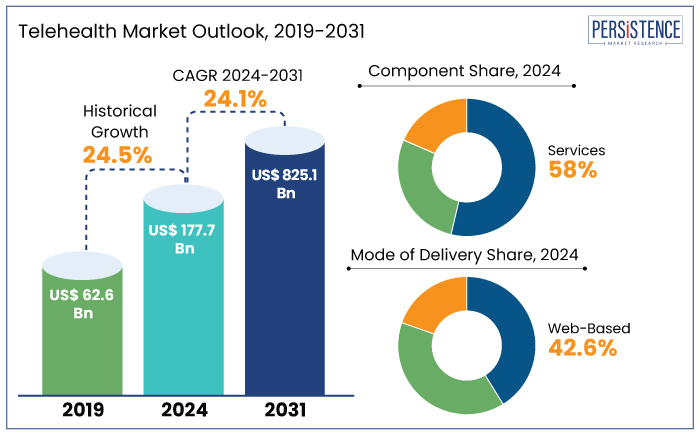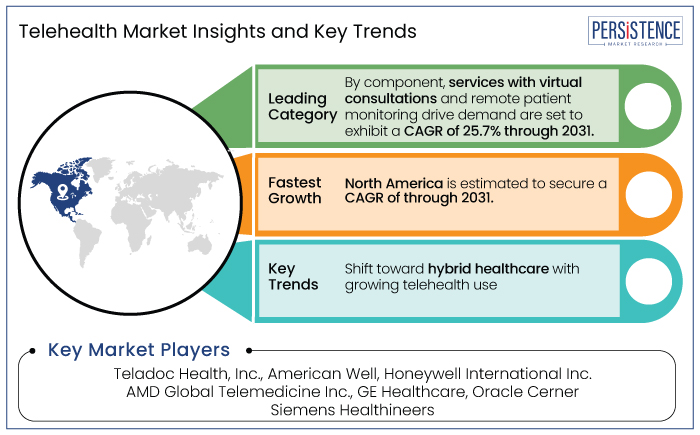Industry: Healthcare
Published Date: January-2025
Format: PPT*, PDF, EXCEL
Delivery Timelines: Contact Sales
Number of Pages: 188
Report ID: PMRREP34664
The global telehealth market is projected to witness a healthy CAGR of 24.5% during the forecast period from 2024 to 2031. It is anticipated to increase from US$ 177.7 Bn recorded in 2024 to a staggering US$ 825.1 Bn by 2031.
The telehealth market is growing significantly, driven by several factors and emerging trends. Key driving factors include increased demand for remote healthcare services due to a growing aging population, the prevalence of chronic diseases, and a global push for cost-effective and accessible care.
Advances in technology, including high-speed internet, AI-powered diagnostics, and mobile health apps, enhance the feasibility of telehealth solutions. Key trends include the expansion of wearable health devices, integration with electronic health records (EHRs), and growing consumer awareness of virtual care options. Government support, insurance reimbursements, and post-pandemic acceptance of remote consultations also contribute significantly to market expansion.

Key Highlights of the Market
|
Market Attributes |
Key Insights |
|
Global Telehealth Market Size (2024E) |
US$ 177.7 Bn |
|
Projected Market Value (2031F) |
US$ 825.1 Bn |
|
Global Market Growth Rate (CAGR 2024 to 2031) |
24.5% |
|
Historical Market Growth Rate (CAGR 2019 to 2023) |
24.1% |
North America leads the telehealth market with a 39.3% share due to advanced healthcare infrastructure, widespread adoption of digital technologies, and supportive regulatory frameworks. The region benefits from high internet penetration, extensive smartphone usage, and significant investments in telemedicine platforms.
The presence of major telehealth companies, coupled with robust reimbursement policies and government initiatives like the U.S. Centers for Medicare & Medicaid Services (CMS) expansion of telehealth coverage, further drives growth. Additionally, a rising prevalence of chronic diseases, and consumer preference for convenient, remote healthcare solutions solidify North America's position as the dominant regional market for telehealth services.
Services lead the telehealth market with a 58.4% market share in 2024 due to their essential role in care delivery. Virtual consultations and remote patient monitoring drive demand. These services offer flexibility, accessibility, and cost-effectiveness for patients and providers.
Growing chronic disease management and mental health needs boost their adoption. Technological advancements like AI and secure communication tools enhance their appeal. Favorable reimbursement policies and increased post-pandemic acceptance strengthen their position. Services are crucial for connecting patients with healthcare providers efficiently, making them the dominant product category in the telehealth market.
Web-based telehealth leads in mode of action due to its accessibility and user-friendly platforms. It allows patients and providers to connect through browsers without the need for specialized software. This convenience makes it widely adopted across diverse demographics.
Web-based solutions support features like video calls, messaging, and data sharing, enhancing care delivery. They are cost-effective for providers and easily scalable for large healthcare systems. High internet penetration and growing familiarity with online tools also drive adoption. Additionally, integration with electronic health records (EHRs) and other healthcare systems further strengthens their dominance in the telehealth market.
The telehealth market is experiencing significant growth, driven by technological advancements and changing healthcare dynamics. Market introduction highlights telehealth as a transformative solution, offering remote medical services via digital platforms, addressing accessibility challenges, and reducing healthcare costs. Its applications range from virtual consultations to remote monitoring, catering to chronic disease management, mental health, and routine check-ups.
Trend analysis reveals increasing adoption of AI-powered diagnostics, wearable health devices, and integration with electronic health records (EHRs). The COVID-19 pandemic accelerated its acceptance, making virtual care mainstream. Growing government support, improved reimbursement policies, and rising consumer awareness further propel the telehealth market's expansion.

The global telehealth market recorded a remarkable CAGR of 24.1% in the historical period from 2019 to 2023. The market has grown steadily, driven by technology and healthcare demand. It began as a solution for rural areas but expanded with better internet and digital tools.
The COVID-19 pandemic accelerated adoption worldwide, making telehealth a mainstream option. In the future, growth will continue with AI, wearable devices, and personalized care. Rising chronic diseases and aging populations will increase demand.
Cost-effective care and convenience will attract more users. Regulatory support and better reimbursement policies will also play a key role. The telehealth market is set to become a cornerstone of modern healthcare systems. The market is estimated to showcase a CAGR of 24.5% during the period from 2024 to 2031.
Telehealth Growth Supported by Value-Based Payment Shifts
The shift to value-based care is playing a big role in the growing use of telehealth, focusing on using resources efficiently, reducing costs, and improving patient outcomes. In value-based care, payments are based on the quality of care provided, not just the number of services given. Telehealth has been a key part of this approach, showing clear benefits. For example,
H healthcare providers using value-based care were able to continue patient care with telehealth during the COVID-19 pandemic helping prevent the spread of the virus and manage limited resources.
Some examples of how telehealth was used include Oak Street Health in Chicago, which launched a program with phone check-ins and enrolled patients in a COVID-19 care program. Carillon Clinic in Roanoke, VA, used data to reach out to high-risk patients with chronic conditions, and Central Ohio Primary Care screened over 4,000 high-risk patients for COVID-19. These initiatives highlight telehealth's vital role in enabling comprehensive, equitable care, particularly for vulnerable populations, positioning it as a cornerstone of modern healthcare delivery.
Barriers to Telehealth Adoption Due to Connectivity Gaps
This digital divide represents a key barrier for telehealth market, with one-third of the global population approximately 2.6 billion people still lacking internet access. This is especially problematic for virtual healthcare, as those without reliable internet connections or the necessary digital skills are excluded from accessing telehealth services.
Physicians have identified this gap as a primary obstacle to virtual care, particularly in underserved and rural communities. Despite improvements in global connectivity, progress remains slow, especially in low-income countries, where internet usage is still limited to less than a third of the population.
There are disparities between countries and continents, and even between genders. In 2022, 62% of men had internet access compared to 57% of women. This issue is exacerbated in low-income regions, where internet access remains scarce. While global connectivity has improved, with 67% of people now online, the pace of progress is not fast enough to guarantee universal internet access by 2030.
Efforts to bridge this divide must include improving infrastructure, making internet more affordable, and equipping individuals with digital skills to unlock the full potential of telehealth and other digital services. Without addressing these challenges, many individuals will continue to be excluded from the benefits of digital healthcare.
Leveraging Diverse Care Providers to Improve Healthcare Delivery
Healthcare organizations can seize the opportunity to evolve basic care teams into comprehensive care models, leveraging diverse professional expertise to meet the multifaceted needs of patients.
According to a 2022 survey, 37% of patients value the inclusion of social workers and behavioral health providers, which can significantly improve access to mental health care. Similarly, 31% prioritize partnerships with community-based organizations to address social determinants of health, equipping teams to tackle broader drivers of health outcomes.
Nearly 34% emphasize the need for care managers with strong clinical backgrounds to enhance coordination, especially for complex medical cases. Comprehensive care teams not only improve patient outcomes but also reduce system inefficiencies by ensuring continuity of care and leveraging team-based approaches in virtual health settings.
For maximum impact, organizations must enable each team member to work at the top of their license and streamline communication channels for better care navigation and reduced readmission rates.
The telehealth market is highly competitive, with numerous players offering a variety of services and solutions. Key companies include Teladoc Health, Amwell, and Doctor on Demand, which provide virtual consultations and telemedicine platforms.
Startups are also emerging, focusing on niche areas like mental health or chronic disease management. Competition is driven by technological advancements, user-friendly interfaces, and integrations with healthcare systems.
Providers focus on expanding service offerings, improving customer experiences, and ensuring data security. Strategic partnerships, acquisitions, and investments in AI and wearables are key strategies to maintain market leadership in this evolving space.
Recent Industry Developments
|
Attributes |
Details |
|
Forecast Period |
2024 to 2031 |
|
Historical Data Available for |
2019 to 2023 |
|
Market Analysis |
US$ Billion for Value |
|
Key Countries Covered |
|
|
Key Market Segments Covered |
|
|
Key Companies Profiled in the Report |
|
|
Report Coverage |
|
|
Customization & Pricing |
Available upon request |
By Component
By Mode of Delivery
By Application
By End User
By Region
To know more about delivery timeline for this report Contact Sales

Yes, the market is set to reach US$ 825.1 Bn by 2031.
U.S. is estimated to witness a high market share in 2031.
A few of the leading players in the market are Teladoc Health, Inc., American Well and Honeywell International Inc.
The market is estimated to showcase a remarkable CAGR of 24.5% through 2031.
This shift toward accessible, on-demand healthcare fuels the market expansion.